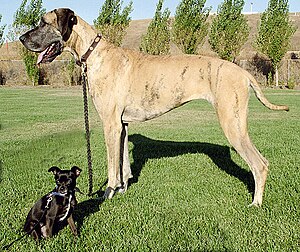Dog breed
A dog breed is a group of dogs that share a set of very similar features. Those features include characteristic appearance and behavior. All dog breeds are the same species, [[Canis familiaris]], and can mate and produce offspring. Some breeds are defined primarily by their ability to do a job, like hunt or herd. Other breeds are more strictly defined by their appearance.
The features that distinguish breeds do so in the minds of humans, but not all dog breeds were bred by people purposefully mating dogs of like characteristics. Some came about because a group of dogs were isolated from other dogs by a set of geographic features, and over the generations produced a group of animals of a recognizeable type. These breeds, called natural breeds, often originated in mountainous areas or islands. If they had qualities that people found attractive, such distinctive dogs were further bred by fanciers using artificial selection- that is, puppies were born to females whose mates were chosen by the breeders, rather than left up to the dogs. An example of a dog breed that is the result of both natural selection in an isolated area and selective breeding by dog fanciers is the Newfoundland.
"The archeologic record suggests that the first domestic dogs are found in the Middle East approximately 14,000 years ago".(reference for quote:Robert K. Wayne, Elaine A. Ostrander: Origin, genetic diversity, and genome structure of the domestic dog BioEssays Volume 21, Issue 3, Date: March 1999, Pages: 247-257). There is every reason to believe that selectively bred for specific characteristics has occured for thousands of years.
However long people have been breeding dogs, most of the current dog breeds have only been around for the last hundred years. In the 1870's kennel clubs were founded and kept records of breeds, setting breed standards and registering individual dogs. Those animals with "papers" from the breed registries are said to be "purebred". In dogs, only individuals whose mother and father are both registered members of the breed are able to be registered, and considered purebred. This concept has caused controversy both because of the difficulty of regulation and because of the possible genetic consequences of a limited population (inbreeding). Recent work has been done to genetically classify the various breeds, with some surprising results regarding the estimated age and interrelations of the breeds.
Kennel Clubs: Conformational shows and field trials
Recognizing a new breed
The point at which a new variety becomes a breed can be difficult to decide. National kennel clubs often differ in their recognition of breeds and rare breeds might not be recognised outside their home country. Usually, only dogs recognized by a kennel club are eligible to compete in that specific club's conformation shows and dog sports, although many dog sports allow any healthy dog to compete regardless of the breed.
Generally, before a type of dog is recognized as a breed, it must be shown that mating a pair of that type always produces dogs that have the same characteristics as the parents, usually both in appearance and in behavior. This is known as breeding true. There are many issues concerning what is considered breeding true. For example, Flat-Coated Retrievers must always be black; however, yellow coats occur occasionally in some litters. Kennel clubs do not recognize the yellow dogs as legitimate members of the breed; some breeders will kill the puppies rather than risk having the dog grow up, breed, and produce more of the undesired yellow color, perpetuating the undesireable gene; more often, today, such dogs are neutered and placed in homes as pets. As another example, a breeding pair of Belgian Shepherds of the Groenendael variety can produce puppies of the Tervueren (brown) variety; the AKC considers the varieties to be different breeds and, therefore, the brown puppies are invalid and undesirable dogs, whereas the CKC considers them simply to be different color varieties of the same breed.
See selective breeding for a detailed discussion on open versus closed stud books and some of the issues concerning purebreds.
See also
External links
- Livestock Guard Dogs: What is a Breed and Why Does It Matter?
- AKC Dog Registration Statistics for 2003 and 2004
da:Racehund de:Hunderasse nl:Hondenras no:Hunderase pl:Rasy psów sr:Расе паса sv:Hundras
